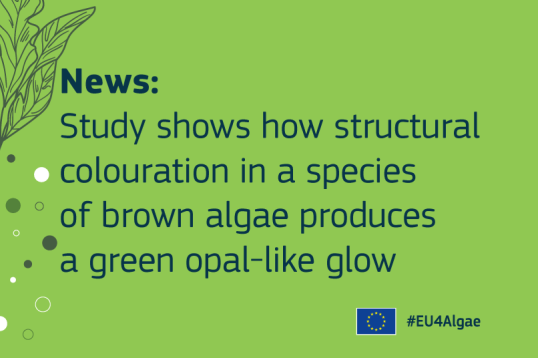
EU4Algae serves as an information hub for the algae sector, providing stakeholders with updates on the latest news, events, and developments in the algae industry.
Scientists from Japan's Kobe University have made a groundbreaking discovery that sheds light on the opalescence of certain brown algae, specifically Sporochnus dotyi (S. dotyi) from the Sporochnus genus (or taxonomic group) of brown algae. While an opalescent green glow has been previously observed in other orders (including the Dictyotales and Fucales), it has never been observed and reported in Sporochnales until now.
By delving into the structural mechanics and cellular composition of these algae, researchers have uncovered the unique properties that create this dazzling display. Their findings mark the first recorded instance of such iridescence in the Sporochnales order, expanding the understanding of these marine organisms.
A look behind the study: An overview
Researchers used light and transmission electron microscopy (TEM) to assess and compare two species of Sporochnus: S. dotyi and S. radiciformis. The methodology included the collection of light microscopy magnified samples using visible light and optical lenses, allowing the study of living cells and tissues at relatively low resolution. To achieve considerably higher resolution and magnification, TEM uses an electron beam and electromagnetic lenses.
One of the main challenges was collecting and transporting the algae specimens to the laboratory. The research team dived to a depth of 25 meters off the coast of Kushimoto, a town situated at the southernmost tip of Japan’s main island, Honshu. They observed and photographed the brown algal specimens in their natural environment before carefully extracting and depositing them into large containers of seawater to prevent disturbance and potential damage.
Pinpointing the findings
The researchers argued that the green opal-like glow is due to structural colouration caused by cellular compartments filled with regularly sized globules known as "iridescent bodies”, which primarily reflect green light. These compartments contain uniformly sized nanospheres (130-160 nanometres) in iridescent species, while non-iridescent species have varying sizes. This suggests that a consistent size of the nanosphere is necessary for the iridescent effect. Additionally, it was argued that the iridescent effect may provide camouflage to protect from predators and repel grazers.
To read the entire story follow the link. The study's findings were published in the European Journal of Phycology.
Additional information
Join the #EU4Algae conversation and don’t forget to keep an eye on the EU4Algae Forum to stay updated and learn more about the ongoing activities, initiatives and updates on the development of the EU4Algae Forum online.
To contact us, please use the following email: contact eu4algae [dot] eu (contact[at]eu4algae[dot]eu).
eu4algae [dot] eu (contact[at]eu4algae[dot]eu).
Did you hear about the new EU4Algae Interactive Platform?
Designed to promote awareness and acceptance of algae products while helping increase the level of consumer algae-related knowledge and preferences for algae products, the EU4Algae Interactive Platform lets you take the EU4Algae Quiz to test your algae knowledge, answer a Survey to tell us a bit about your algae-eating habits (the first 200 responses get a free eBook!) and play the interactive Game to find out what kind of algae you are.
Details
- Publication date
- 25 July 2024
- Author
- Directorate-General for Maritime Affairs and Fisheries

